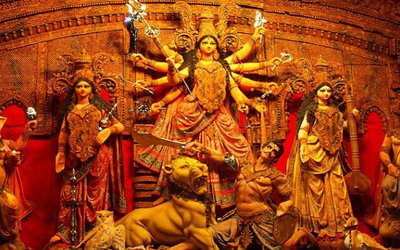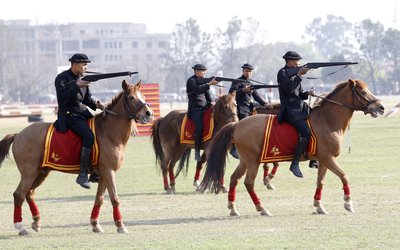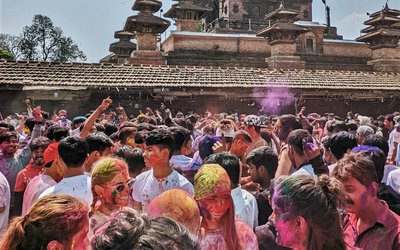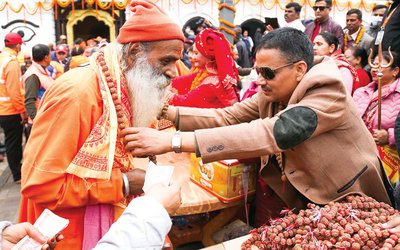
Indra Jatra, one of the biggest festivals celebrated in Kathmandu valley, has begun with the erection of a lingo (sacred wooden pole) at Hanumandhoka premises in Basantapur Darbar Square on Saturday morning.
The eight-day long Indra Jatra festival falls in September and is one of the most exciting and revered festivals of the Newar community of the Kathmandu Valley. This also marks the beginning of a month-long festival season of autumn. It begins with the erection of a wooden pole made of pine at Basantapur Sqaure in front of the old Hanuman Dhoka Palace.
For the pole-raising ceremony, hundreds of spectators gather at the Palace Square and on the surrounding temples. The chariot of Kumari, the Living Goddess, is taken out in a procession through the main streets of Kathmandu.
Masked dancers known as Lakhay take to the streets almost every evening accompanied by loud drums. The festival commemorates the time when Indra came down from heaven in human form to look for an herb.
Each night of Indra Jatra the shrines and ancient palace buildings around Kathmandu Durbar Square are aglow with oil wicks. Each night on the platform in front of the temple of the Living Goddess, there is an enactment depicting the ten earthly incarnations of Lord Vishnu. The large image of Akash Bhairab's head is put on display out in the open directly facing his temple at Indra Chowk.
In the afternoon of the day before full moon, ecstatic mobs gather near Hanuman Dhoka Palace for the long-awaited Living Goddess’ chariot procession to catch a glimpse of the revered little Newar girl who has been deified as Kumari representing Goddess Taleju.
The chariot of the Kumari followed by two other smaller chariots carrying a representative of Ganesh and Bhairav is taken to different parts of the old Kathmandu through the narrow alleys where people gather to watch and py homage. The festival of Indra Jatra ends with the lowering of the (lingam) pole bearing Indra's flag amidst religious ceremonies.
When is Indra Jatra?
Indra Jatra is a regional holiday in the Kathmandu Valley in Nepal. The holiday takes place on the 15th day of Yanla, the 11th month in the Nepalese calendar.
This is an important harvest festival in Kathmandu Valley, also known as Yenyā (meaning "Kathmandu celebration")
Traditions of Indra Jatra
The eight-day long exuberant festival of the Newari community of the Kathmandu Valley is a time to honour the recently deceased and to pay homage to the Hindu god Indra and his mother Dagini, to ensure they bless the coming harvest.
Lord Indra has an avatar form as the god of rain, which makes him a very important deity in Hindu communities where a successful harvest is vital.

The legend behind this story says that Indra, in human form, visited Kathmandu Valley to pick a flower that his mother wanted to use in a ritual. He was caught picking the flowers and accused of stealing. To smooth out the incident, Dagini descended from heaven and when they realised that their captive was none other than Indra, he was promptly released. Dagini said that to thank the people for releasing her son and to make up for Indra's transgression, she would make sure the crops had dew every morning and she would also take up to heaven those who had died in the previous year. This forms the basis for Indra Jatra (meaning "Festival") every year.
The celebrations involve a Kumari. In a tradition that dates back over a thousand years, these are young girls who are selected to be living goddesses when they are about three years old. The Kumari are only allowed out of their houses on major festivals such as Indra Jatra. When they do participate, their feet are not allowed to touch the earth, so they must be carried or walk on special carpets. When the Kumari reach puberty, they return to normal life - the bleeding shows their human nature. That means that if they bleed at all from even an accidental cut, they stop being a Kumari.
Two boys playing the roles of the gods Ganesh and Bhairab (the most fearsome form of Shiva) accompany the Kumari in a procession to the royal palace, where it stops in front of the 12-foot mask of the Bhairab. Shown above, the Bhairab is only displayed in public during this festival.
And while the Bhairab might look fearsome, it doesn't scare people away as rice beer pours from its mouth!
In addition to its religious aspect, this holiday also commemorates the day in 1768, during Indra Jatra, when Prithwi Narayan Shah conquered the Kathmandu Valley and unified Nepal.





- PM Oli Meets PM Modi In Thailand
- Apr 04, 2025
- I Bow to the People Who Have Given Me Justice: Kulman Ghising
- Apr 04, 2025
- U.S. Embassy’s Creator’s Mela 2025 Expands To Itahari And Pokhara, Empowering Nepal’s Digital Creators
- Apr 04, 2025
- Thai Investors Show Willingness For Investment
- Apr 04, 2025
- South Korea's Constitutional Court has upheld President Yoon Suk-yeol's impeachment
- Apr 04, 2025















